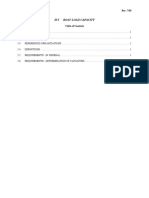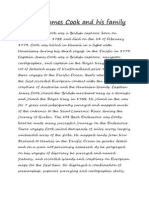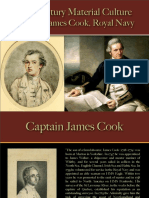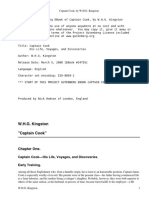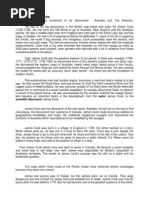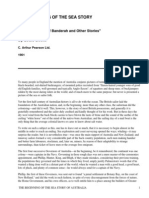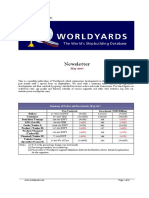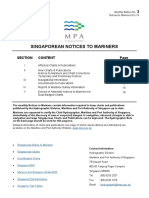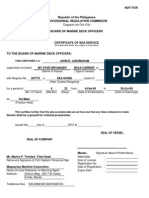0 ratings0% found this document useful (0 votes)
11 viewsSahlins 2
Sahlins 2
Uploaded by
caleu moraesCaptain James Cook was a British explorer, cartographer and naval officer famous for his three voyages between 1768 and 1779 in the Pacific Ocean and to New Zealand and Australia in particular. He made detailed maps of Newfoundland prior to making three voyages to the Pacific, during which he achieved the first recorded European contact with the eastern coastline of Australia and the Hawaiian Islands and the first recorded circumnavigation of New Zealand.
Copyright:
© All Rights Reserved
Available Formats
Download as DOCX, PDF, TXT or read online from Scribd
Sahlins 2
Sahlins 2
Uploaded by
caleu moraes0 ratings0% found this document useful (0 votes)
11 views6 pagesCaptain James Cook was a British explorer, cartographer and naval officer famous for his three voyages between 1768 and 1779 in the Pacific Ocean and to New Zealand and Australia in particular. He made detailed maps of Newfoundland prior to making three voyages to the Pacific, during which he achieved the first recorded European contact with the eastern coastline of Australia and the Hawaiian Islands and the first recorded circumnavigation of New Zealand.
Original Description:
Vida de Marshall Sahlins e textos sobre James Cook e o formalismo na antropologia
Original Title
Sahlins2
Copyright
© © All Rights Reserved
Available Formats
DOCX, PDF, TXT or read online from Scribd
Share this document
Did you find this document useful?
Is this content inappropriate?
Captain James Cook was a British explorer, cartographer and naval officer famous for his three voyages between 1768 and 1779 in the Pacific Ocean and to New Zealand and Australia in particular. He made detailed maps of Newfoundland prior to making three voyages to the Pacific, during which he achieved the first recorded European contact with the eastern coastline of Australia and the Hawaiian Islands and the first recorded circumnavigation of New Zealand.
Copyright:
© All Rights Reserved
Available Formats
Download as DOCX, PDF, TXT or read online from Scribd
Download as docx, pdf, or txt
0 ratings0% found this document useful (0 votes)
11 views6 pagesSahlins 2
Sahlins 2
Uploaded by
caleu moraesCaptain James Cook was a British explorer, cartographer and naval officer famous for his three voyages between 1768 and 1779 in the Pacific Ocean and to New Zealand and Australia in particular. He made detailed maps of Newfoundland prior to making three voyages to the Pacific, during which he achieved the first recorded European contact with the eastern coastline of Australia and the Hawaiian Islands and the first recorded circumnavigation of New Zealand.
Copyright:
© All Rights Reserved
Available Formats
Download as DOCX, PDF, TXT or read online from Scribd
Download as docx, pdf, or txt
You are on page 1of 6
James Cook
157 languages
Article
Talk
Read
View source
View history
Tools
From Wikipedia, the free encyclopedia
(Redirected from Captain Cook)
Sorry to interrupt, but our fundraiser won’t last longThis Monday, we ask you
to join the 2% of readers who give. If everyone reading this right now gave just R$10, we'd
hit our goal in a couple of hours. R$10 is all we ask.
GIVE R$10 MAYBE LATER
April 1: Wikipedia still can't be sold.
We're sorry we've asked you a few times recently, but it's Monday, April 1, and it
will soon be too late to help the nonprofit behind Wikipedia. Wikipedia is free and
doesn't rely on ads. If everyone reading this gave R$10, we'd hit our goal in a few
hours. Just 2% of our readers donate, so if Wikipedia has given you R$10 worth of
knowledge, please give. Any contribution helps, whether it's R$10 or R$50.
Give R$10
Give a different amount
MAYBE LATER I ALREADY DONATEDCLOSE
"Captain Cook" redirects here. For other uses, see Captain Cook
(disambiguation) and James Cook (disambiguation).
James Cook
FRS
Portrait by Nathaniel Dance-Holland, c. 1775
Born 7 November [O.S. 27 October] 1728
Marton, Yorkshire, Kingdom of Great Britain
Died 14 February 1779 (aged 50)
Kealakekua Bay in present-day Hawaii, U.S.
Nationality British
Education Postgate School, Great Ayton
Occupation(s) Explorer, cartographer and naval officer
Elizabeth Batts
Spouse
(m. 1762)
Children 6
Military career
Branch Royal Navy
Service years 1755–1779
Rank Captain (Post-captain)
Seven Years' War
Battles/wars
o Conquest of New France
Signature
Captain James Cook FRS (7 November [O.S. 27 October] 1728 – 14 February
1779) was a British explorer, cartographer and naval officer famous for his three
voyages between 1768 and 1779 in the Pacific Ocean and to New Zealand and
Australia in particular. He made detailed maps of Newfoundland prior to making
three voyages to the Pacific, during which he achieved the first recorded
European contact with the eastern coastline of Australia and the Hawaiian
Islands and the first recorded circumnavigation of New Zealand.
Cook joined the British merchant navy as a teenager and joined the Royal Navy
in 1755. He served during the Seven Years' War and subsequently surveyed
and mapped much of the entrance to the St. Lawrence River during the siege of
Quebec, which brought him to the attention of the Admiralty and the Royal
Society. This acclaim came at a crucial moment for the direction of British
overseas exploration, and it led to his commission in 1768 as commander
of HMS Endeavour for the first of three Pacific voyages.
In these voyages, Cook sailed thousands of miles across largely uncharted
areas of the globe. He mapped lands from New Zealand to Hawaii in the Pacific
Ocean in greater detail and on a scale not previously charted by Western
explorers. He surveyed and named features, and recorded islands and
coastlines on European maps for the first time. He displayed a combination of
seamanship, superior surveying and cartographic skills, physical courage, and
an ability to lead men in adverse conditions.
During his third voyage in the Pacific, Cook encountered the Hawaiian islands in
1779. He was killed while attempting to take hostage Kalaniʻōpuʻu, chief of the
island of Hawaii. He left a legacy of scientific and geographical knowledge that
influenced his successors well into the 20th century, and numerous memorials
worldwide have been dedicated to him. He remains controversial as an enabler
of British colonialism and for his occasionally violent encounters with indigenous
peoples.
Early life and family
James Cook was born on 7 November [O.S. 27 October] 1728 in the village
of Marton in the North Riding of Yorkshire and baptised on 14 November (N.S.)
in the parish church of St Cuthbert, where his name can be seen in the church
register.[1][2] He was the second of eight children of James Cook (1693–1779), a
Scottish farm labourer from Ednam in Roxburghshire, and his locally born wife,
Grace Pace (1702–1765), from Thornaby-on-Tees.[1][3][4] In 1736, his family
moved to Airey Holme farm at Great Ayton, where his father's employer,
Thomas Skottowe, paid for him to attend the local school. In 1741, after five
years' schooling, he began work for his father, who had been promoted to farm
manager. Despite not being formally educated, he became capable in
mathematics, astronomy and charting by the time of his Endeavour voyage.
[5]
For leisure, he would climb a nearby hill, Roseberry Topping, enjoying the
opportunity for solitude.[6]
In 1745, when he was 16, Cook moved 20 miles (32 km) to the fishing village
of Staithes, to be apprenticed as a shop boy to grocer and haberdasher William
Sanderson.[1] Historians have speculated that this is where Cook first felt the lure
of the sea while gazing out of the shop window.[4]
Elizabeth Cook, wife and for 56 years widow of
James Cook, by William Henderson, 1830
After 18 months, not proving suited for shop work, Cook travelled to the nearby
port town of Whitby to be introduced to Sanderson's friends John and Henry
Walker.[7] The Walkers, who were Quakers, were prominent local ship-owners in
the coal trade. Their house is now the Captain Cook Memorial Museum. Cook
was taken on as a merchant navy apprentice in their small fleet of vessels,
plying coal along the English coast. His first assignment was aboard
the collier Freelove, and he spent several years on this and various
other coasters, sailing between the Tyne and London. As part of his
apprenticeship, Cook applied himself to the study of algebra, geometry,
trigonometry, navigation and astronomy – all skills he would need one day to
command his own ship.[4]
His three-year apprenticeship completed, Cook began working on trading ships
in the Baltic Sea. After passing his examinations in 1752, he soon progressed
through the merchant navy ranks, starting with his promotion in that year
to mate aboard the collier brig Friendship.[8] In 1755, within a month of being
offered command of this vessel, he volunteered for service in the Royal Navy,
when Britain was re-arming for what was to become the Seven Years' War.
Despite the need to start back at the bottom of the naval hierarchy, Cook
realised his career would advance more quickly in military service and entered
the Navy at Wapping on 17 June 1755.[9]
Cook married Elizabeth Batts, the daughter of Samuel Batts, keeper of the Bell
Inn in Wapping[10] and one of his mentors, on 21 December 1762 at St
Margaret's Church, Barking, Essex.[11] The couple had six children: James
(1763–1794), Nathaniel (1764–1780, lost aboard HMS Thunderer which
foundered with all hands in a hurricane in the West Indies), Elizabeth (1767–
1771), Joseph (1768–1768), George (1772–1772) and Hugh (1776–1793, who
died of scarlet fever while a student at Christ's College, Cambridge). When not
at sea, Cook lived in the East End of London. He attended St Paul's Church,
Shadwell, where his son James was baptised. Cook has no direct descendants
– all of his children died before having children of their own.[12]
Start of Royal Navy career
Further information: Great Britain in the Seven Years' War
Cook's first posting was with HMS Eagle, serving as able seaman and master's
mate under Captain Joseph Hamar for his first year aboard, and Captain Hugh
Palliser thereafter.[13] In October and November 1755, he took part in Eagle's
capture of one French warship and the sinking of another, following which he
was promoted to boatswain in addition to his other duties.[9] His first temporary
command was in March 1756 when he was briefly master of Cruizer, a small
cutter attached to Eagle while on patrol.[9][14]
In June 1757 Cook formally passed his master's examinations at Trinity
House, Deptford, qualifying him to navigate and handle a ship of the King's
fleet.[15] He then joined the frigate HMS Solebay as master under Captain Robert
Craig.[16]
Canada
During the Seven Years' War, Cook served in North America as master aboard
the fourth-rate Navy vessel HMS Pembroke.[17] With others in Pembroke's crew,
he took part in the major amphibious assault that captured the Fortress of
Louisbourg from the French in 1758, and in the siege of Quebec City in 1759.
Throughout his service he demonstrated a talent
for surveying and cartography and was responsible for mapping much of the
entrance to the Saint Lawrence River during the siege, thus allowing General
Wolfe to make his famous stealth attack during the 1759 Battle of the Plains of
Abraham.[18]
Cook's surveying ability was also put to use in mapping the jagged coast
of Newfoundland in the 1760s, aboard HMS Grenville. He surveyed the
northwest stretch in 1763 and 1764, the south coast between the Burin
Peninsula and Cape Ray in 1765 and 1766, and the west coast in 1767. At this
time, Cook employed local pilots to point out the "rocks and hidden dangers"
along the south and west coasts. During the 1765 season, four pilots were
engaged at a daily pay of 4 shillings each: John Beck for the coast west of
"Great St Lawrence", Morgan Snook for Fortune Bay, John Dawson for
Connaigre and Hermitage Bay, and John Peck for the "Bay of Despair".[19]
While in Newfoundland, Cook also conducted astronomical observations, in
particular of the eclipse of the sun on 5 August 1766. By obtaining an accurate
estimate of the time of the start and finish of the eclipse, and comparing these
with the timings at a known position in England, it was possible to calculate the
longitude of the observation site in Newfoundland. This result was
communicated to the Royal Society in 1767.[20]
His five seasons in Newfoundland produced the first large-scale and accurate
maps of the island's coasts and were the first scientific, large-scale,
hydrographic surveys to use precise triangulation to establish land outlines.
[21]
They also gave Cook his mastery of practical surveying, achieved under often
adverse conditions, and brought him to the attention of the Admiralty and Royal
Society at a crucial moment both in his career and in the direction of British
overseas discovery. Cook's maps were used into the 20th century, with copies
being referenced by those sailing Newfoundland's waters for 200 years.[22]
Following his exertions in Newfoundland, Cook wrote that he intended to go not
only "farther than any man has been before me, but as far as I think it is
possible for a man to go".[15]
First voyage (1768–1771)
You might also like
- Borna Petrovic Roro Market From A Brokers PerspectiveDocument24 pagesBorna Petrovic Roro Market From A Brokers PerspectiveNNMSANo ratings yet
- H-05Document11 pagesH-05lincoln9003198No ratings yet
- Alang Ship BreakersDocument29 pagesAlang Ship Breakerspureman35100% (1)
- Cook The CaptainDocument18 pagesCook The Captainjamesx456No ratings yet
- James_CookDocument28 pagesJames_Cookruth.katherina.lopezNo ratings yet
- About James CookDocument15 pagesAbout James Cookjcox394No ratings yet
- James CookDocument1 pageJames Cookamalia BerilaNo ratings yet
- James Cook Presentation by Shams 5bDocument13 pagesJames Cook Presentation by Shams 5bapi-270031786No ratings yet
- Captain James Cook and His FamilyDocument2 pagesCaptain James Cook and His FamilymaximusthorNo ratings yet
- Naval - British Navy - Captain James CookDocument50 pagesNaval - British Navy - Captain James CookThe 18th Century Material Culture Resource Center100% (4)
- Simplified Captain Cook Facts For Year 2Document15 pagesSimplified Captain Cook Facts For Year 2api-344451473No ratings yet
- Naval - British Navy - Captain James Cook 3rd VoyageDocument209 pagesNaval - British Navy - Captain James Cook 3rd VoyageThe 18th Century Material Culture Resource Center100% (2)
- Born On October 27, 1728, in Marton, Yorkshire, England, James CookDocument2 pagesBorn On October 27, 1728, in Marton, Yorkshire, England, James CookAnda AndutzsaNo ratings yet
- BiographyDocument1 pageBiographynanana010100No ratings yet
- James Cook - Britannica Online EncyclopediaDocument4 pagesJames Cook - Britannica Online EncyclopediaAL ASFALTNo ratings yet
- W.H.G. Kingston "Captain Cook": Chapter OneDocument134 pagesW.H.G. Kingston "Captain Cook": Chapter OneGutenberg.org100% (1)
- Naval - British Navy - Captain James Cook - The Death ofDocument119 pagesNaval - British Navy - Captain James Cook - The Death ofThe 18th Century Material Culture Resource Center100% (6)
- ColonelDocument3 pagesColonelRyan OnellNo ratings yet
- Grammar Tenses Mix: James Cook (1728-1779)Document2 pagesGrammar Tenses Mix: James Cook (1728-1779)Ane IlievskaNo ratings yet
- Captain CookDocument228 pagesCaptain CookPavan YerraboinaNo ratings yet
- A Narrative of a Nine Months' Residence in New Zealand in 1827From EverandA Narrative of a Nine Months' Residence in New Zealand in 1827No ratings yet
- The British Empire AustraliaDocument17 pagesThe British Empire AustraliaMyint Myat SoeNo ratings yet
- The Three Voyages of Captain Cook Round the World: All 7 VolumesFrom EverandThe Three Voyages of Captain Cook Round the World: All 7 VolumesNo ratings yet
- The Three Voyages of Captain Cook Round the World (Vol. 1-7): The Complete History of the Ground-breaking JourneyFrom EverandThe Three Voyages of Captain Cook Round the World (Vol. 1-7): The Complete History of the Ground-breaking JourneyNo ratings yet
- Captain James CookDocument4 pagesCaptain James CookAlicia AristizabalNo ratings yet
- Instrumental Performance 159 SyllabusDocument2 pagesInstrumental Performance 159 SyllabusYmgm StynunNo ratings yet
- Dissertation James CookDocument8 pagesDissertation James CookOrderPaperOnlineSaintPetersburg100% (1)
- Tudor and Stuart Seafarers: The Emergence of a Maritime Nation, 1485-1707From EverandTudor and Stuart Seafarers: The Emergence of a Maritime Nation, 1485-1707No ratings yet
- Document 1 copyDocument1 pageDocument 1 copyjasperisthegoatandbestNo ratings yet
- Cook Lesson 1,2,3Document1 pageCook Lesson 1,2,3stseyidmatova.kamillaNo ratings yet
- James Cook BiographyDocument1 pageJames Cook BiographyGaby ConstanteNo ratings yet
- British Battleships, 1889-1904: New Revised EditionFrom EverandBritish Battleships, 1889-1904: New Revised EditionRating: 4.5 out of 5 stars4.5/5 (5)
- Captain Cook: His Life, Voyages, and DiscoveriesFrom EverandCaptain Cook: His Life, Voyages, and DiscoveriesNo ratings yet
- To Go Upon Discovery: James Cook and Canada, from 1758 to 1779From EverandTo Go Upon Discovery: James Cook and Canada, from 1758 to 1779No ratings yet
- Elizabethan Era Part2Document6 pagesElizabethan Era Part2calypso greyNo ratings yet
- James Cook JourneyDocument10 pagesJames Cook JourneyAjitkumar SharmaNo ratings yet
- The Story of Captain James Cook PowerpointDocument10 pagesThe Story of Captain James Cook Powerpointapi-248335941100% (1)
- Captain Cook PPDocument11 pagesCaptain Cook PPapi-261205798No ratings yet
- With The Royal Navy in War and Peace: O'er The Dark Blue SeaFrom EverandWith The Royal Navy in War and Peace: O'er The Dark Blue SeaRating: 3 out of 5 stars3/5 (1)
- James Cook-TensesDocument4 pagesJames Cook-TensesDijana KrstevskaNo ratings yet
- Naval - British Navy - Captain James Cook 1st VoyageDocument179 pagesNaval - British Navy - Captain James Cook 1st VoyageThe 18th Century Material Culture Resource Center100% (5)
- John SmithDocument4 pagesJohn SmithINLOVEENo ratings yet
- Christopher ColumbusDocument4 pagesChristopher ColumbusSubodh SonawaneNo ratings yet
- The Voyages of Captain James Cook: The Illustrated Accounts of Three Epic VoyagesFrom EverandThe Voyages of Captain James Cook: The Illustrated Accounts of Three Epic VoyagesNo ratings yet
- William Cowper (1778-1858) The Indispensable Parson. The Life and Influence of Australia's First Parish Clergyman (Commemorative Pictorial)From EverandWilliam Cowper (1778-1858) The Indispensable Parson. The Life and Influence of Australia's First Parish Clergyman (Commemorative Pictorial)No ratings yet
- The Beginning of The Sea Story of Australia1901 by Becke, Louis, 1855-1913Document15 pagesThe Beginning of The Sea Story of Australia1901 by Becke, Louis, 1855-1913Gutenberg.orgNo ratings yet
- Captain William John Hake. A Historical Profile 1850-1924From EverandCaptain William John Hake. A Historical Profile 1850-1924No ratings yet
- Captain James Cook.187112Document4 pagesCaptain James Cook.187112Mushfiqur RahmanNo ratings yet
- Catastrophe at Spithead: The Sinking of the Royal GeorgeFrom EverandCatastrophe at Spithead: The Sinking of the Royal GeorgeNo ratings yet
- nutka: Captain Cook and the Spanish Explorers on the CoastFrom Everandnutka: Captain Cook and the Spanish Explorers on the CoastNo ratings yet
- Smoke On The Water 1Document69 pagesSmoke On The Water 1lowtech4No ratings yet
- Capt Sanga Oral Exam PaperDocument4 pagesCapt Sanga Oral Exam PaperSherry GodwinNo ratings yet
- Marine Engineering Curriculum in The Philippines - An AnalysisDocument110 pagesMarine Engineering Curriculum in The Philippines - An Analysisjunielamores29No ratings yet
- Seam 5 Performance Assessment No 5ADocument10 pagesSeam 5 Performance Assessment No 5AJohn Senon Lapitan SaplanNo ratings yet
- 2022.11.02 - News & Reading ComprehensionDocument3 pages2022.11.02 - News & Reading ComprehensionTadmore Tutors TuitonNo ratings yet
- Inland Waterways Authority of IndiaDocument13 pagesInland Waterways Authority of Indiavigambetkar100% (1)
- Worldyards May 2007 NewsletterDocument20 pagesWorldyards May 2007 Newsletternestor mospanNo ratings yet
- 229-81896 New Construction SA 2014 WebDocument208 pages229-81896 New Construction SA 2014 WebmalikscribdNo ratings yet
- Colregs 1972 Made EasyDocument94 pagesColregs 1972 Made EasyAley Nabi Rizvi100% (1)
- NPP IMT Forms 1-31Document67 pagesNPP IMT Forms 1-31Pavel ViktorNo ratings yet
- Ship ConstructionDocument7 pagesShip Constructionpramodkb_cusatNo ratings yet
- Curriculum Vitae: 1. Personal DataDocument2 pagesCurriculum Vitae: 1. Personal DataCulinary ProductionNo ratings yet
- قراءة في النقل البحري الدولي والشركات المشغلة للمحطات البحريةDocument13 pagesقراءة في النقل البحري الدولي والشركات المشغلة للمحطات البحريةMohamed AbdeenNo ratings yet
- FPMC C MelodyDocument2 pagesFPMC C Melodyoceanusking3No ratings yet
- Desain 2Document150 pagesDesain 2Rey Rey100% (1)
- Asian Oil 1 - Q88-1Document6 pagesAsian Oil 1 - Q88-1Azmi MuharomNo ratings yet
- Singaporean Notices To Mariners: Section ContentDocument35 pagesSingaporean Notices To Mariners: Section ContentGaurav SoodNo ratings yet
- Section 4 BSMARE Sea Project Monitory Form & Output GuideDocument8 pagesSection 4 BSMARE Sea Project Monitory Form & Output GuideRobert M. MaluyaNo ratings yet
- Persons Who Take Part in Maritime CommerceDocument17 pagesPersons Who Take Part in Maritime CommerceJapoy Regodon EsquilloNo ratings yet
- Prc-Mdo Form 5 BlankDocument8 pagesPrc-Mdo Form 5 BlankJhon Donz100% (1)
- Bridge NoteDocument433 pagesBridge NoteSandipan D100% (1)
- Transportation LawsDocument125 pagesTransportation LawsDodong LamelaNo ratings yet
- P5 Reading Exercise 64-2Document5 pagesP5 Reading Exercise 64-2中文軍事基地No ratings yet
- FAST93Document20 pagesFAST93EmreNo ratings yet
- Reducing THR PS Detention Factor, Pre-Port Arrival Quick Reference GuideDocument16 pagesReducing THR PS Detention Factor, Pre-Port Arrival Quick Reference GuideTammam HassanNo ratings yet
- Hapag-Lloyd Corporate Presentation January 2019Document25 pagesHapag-Lloyd Corporate Presentation January 2019Franček JežNo ratings yet
- G3 4567/30 JAN/FOR-MIA: - Not For Real World NavigationDocument50 pagesG3 4567/30 JAN/FOR-MIA: - Not For Real World Navigationviniciusksp299No ratings yet

